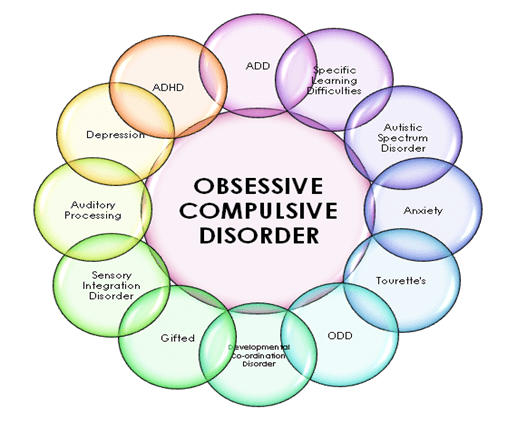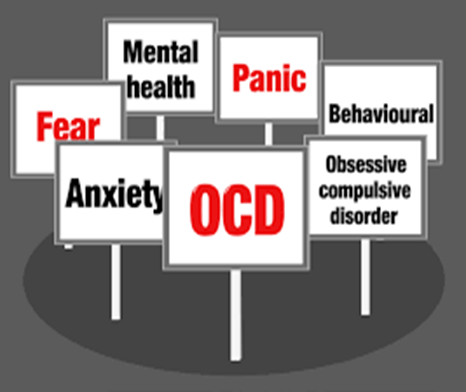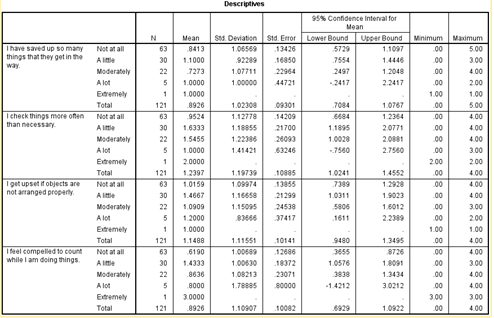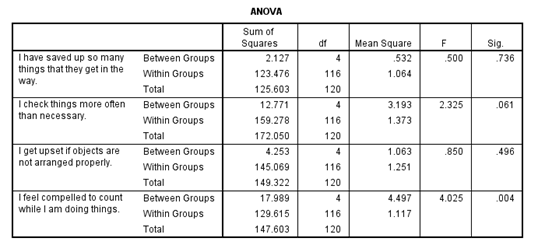Quantitative Research Report
Navigate through our assignment help offerings, crafted by experts for your success.
1. Introduction: Quantitative Research Report
Obsessive-compulsive disorder affects the mental condition of the individual in a different manner that usually results in different behaviour and thoughts creation. The research is based on Statistical analysis inference for the identification of the three particular variables and their relationships.
Research Background
The aim of the research study is to analyze the possible presence of obsessive compulsion disorder in the league of the athletes. Based on the research work of Fewell et al. (2018) there are basically three elements that are present within the disorder such as obsessions, compulsion, and emotions respectively. The OCD health conditions seem to incur with the daily lives of an individual creating multiple anxieties, eating, and sleeping disorders, and creating complexities in their day-to-day lives. Furthermore, the analysis is also emphasized by the comparison of the issue with a group of individuals suffering from an eating disorder diagnosis.

Figure 1: Obsessive Compulsive Disorder
Research aims and objectives
The aim of the research is to identify the impact of the OCD symptoms present in sports athletes. In addition to that, the comparison with that of individual groups does not belong to eating disorders.
- To identify the impact of OCD on sports athletes
- To evaluate the impact of eating disorders in three individual groups
2. Literature review
Identification of the impact of OCD on sports athletes
The day-to-day hectic routines of sports athletes might create a probable scope of pressure while performing especially in case they are diagnosed with OCD symptoms. As opined by Marazziti et al. (2021), mental disorders appear to be more prone in case of renal damage and hyperlipidemia which has the possibility to hinder eating patterns and orders. There are possible chances of not getting sufficient food and lack of basic amenities (Ranganathan & Aggarwal, 2018).

Figure 2: Impact of OCD on mental health
Evaluating the impact of eating disorders in three individual groups
Eating disorders mainly create a scope of hindrance in the behavioral condition that is severely impacted by the physical, psychological, and social function. Based on the research work of Van Slingerland et al. (2020), individuals who are not a part of the athletic field and origin are likely to get affected by an eating disorder as that similar to those who are indulged in sports activities.
Behavioural Theory
Behavioural theory is relevant to human behaviour with the help of analyzing the consequences and antecedents that are present in the nearby environment of an individual. Based on the views of Sahu et al. (2020), the impact of OCD has a direct relation and association with human behaviour and nature that are likely to create an obstruction in their behavioural patterns.

Figure 3: Behavioural Theory
3. Method
Research design
The research design includes all the strategies that are relevant to integrate the different elements of the research study in chronological order (Ranganathan & Aggarwal, (2018). Research design collects all the information that is helpful in addressing the issues and complexities of the respective study.
Justification
The explorative design has been used to conduct the respective research issues. The use of statistical measures has been conducted for evaluating the research issues with proper dependent and independent variables. The identification of the proper strategies has been used for the conduction of the research study in a proficient manner.
Participants
The participants included in the research study are mainly three individual groups and the test has been evaluated for analyzing the impact of the disease on the mental health of the individuals. The first one is belonging to the group of sports athletes and form team of individuals that are likely affected with OCD. The other group of participants included in the research test is the individuals with an eating disorder diagnosis and not a part of the sports activities and curriculum.
Measurements and materials
The materials that have been utilized for the purpose of conducting the respective research study are by gathering the questionnaires and conducting an interview schedule with the sportsperson. The use of statically tools and metrics has been implied in order to conduct the study successfully and with a high level of authenticity (Mishram et al. 2019). These data have been collected from the responses of the individuals that were gathered during the interview session. The dependent variable was “I have saved so many things that they get in the way”, independent variables were “feeling compelled to count”, “getting upset for disarrangement in things” and “checking things often”. The information that was available on authentic websites and journals has been referred to for collecting more reliable and validate data and sources.
Procedure
There are basically two most used methods of data collection used by the researcher’s primary and secondary data sources. These methods are used by researchers in order to gain insight into the factual concepts and relevance of the research study. The primary quantitative methodology for data collection has been used for conducting the respective research study (Bringmann et al. 2021). The description of the mental disorder that largely affects sports athletes has been analyzed with the conduction of statistical procedures and methods.
Hypothesis
Null hypothesis (H0): OCD do not impact the nature of sports athletes
Alternative hypothesis (H1): OCD does impact the nature of sports athletes
4. Results
The use of statistical measures has been applied for collecting the results and accurate answers to the questions that have been searched for. In addition to that quantitative measures have been applied to collecting the data and information relevant to the identification of the research study based on OCD and their overall impact on the health conditions of sports athletes.

Figure 4: Descriptive test
The descriptive test analysis has been conducted keeping the few responses of the patients as dependent variables and independent variables. The analysis of the descriptive test is a process of identifying the relationship based on historical and current data and trends (Mishra et al. 2019). Thus, the identification of the mean and sum of mean squares has been collected from the descriptive test analysis. In addition to that, the impact of independent variables on the dependent variables has been properly understood with the test results.

Figure 5: ANOVA Test
The use of the ANOVA test has been conducted for identifying the result of the difference of more than two or three variables. The test is basically used for evaluating the results based on various categories and trends for a particular time period.
The statistical measure of the correlation coefficient has been use for the purpose of analyzing the liner relationship between the two or more variables of the data. The interpretation of the maximum and minimum value has been evaluated by conducting the statistical tests and procedures. The presentation of the histogram reflects the responses recoded for respondents mentioning who wash and clean themselves because they feel contaminated.
5. Discussion
The overall utilization of the statistical measures has been conducted for identifying the relationship between the variables and their impact of them on the effectiveness of the research. It was reviewed that healthy eating habits are commonly responsible for treating most health and mental illness in relevantly a shorter period of time. Whereas, irregularity in eating disorders is created who are diagnosed with the presence of OCD disease in their medical reports. As per the results gathered it has been identified that the value of correlation for the first variable is 1.000. In addition to that, the correlation for the second and third variables are .093 and .465 respectively. The physical status of the individuals is largely responsible for creating pressure while performing and affecting their professional life. This factor creates hindrances and is compounded by depression and multiple anxiety disorder symptoms. Apart from that, there are a lot of common issues that are built up owing to the mental illness creating havoc affect on the nearby people of the affected patient. Apart from that, the standard deviation of the test is .26341 which states there is the existence of a positive relationship between the variables. The mean value of the test is around.8926 and the maximum value of the test is 1.6310. In addition to that, the minimum value for the test is around .3096 respectively.
As per the descriptive test, the values that have been identified for the AD STD is 1.00118 and that of the R-square value of the analysis are .066. As this is greater than 0.05 in the test hypothesis a failure to accept the null hypothesis is projected which suggests that the alternative hypothesis is accepted. It can be interpreted that OCD impacts the sports athletes. Thus states there is the presence of a strongly positive relationship between the variables. Apart from that, the mean square value of the ANOVA test interprets that the value mean square is 2.775 and that of the significance is .045. The interpretation of the values states that the impact of mental disorders highly impacts the performance of the sport individuals. Apart from that, the demonstration of the possible scope of obsessive-compulsive symptoms has been depicted in the analysis. Along with the group of individuals, those are not indulged in any sort of sports activities. More importantly, the disorder is identified to be affecting the younger generation rather in a higher percentage of the total population. Thus any change in the level of OCD is identified there are significant changes in the value of their performance.
Reference
Borgianni, Y., & Maccioni, L. (2020). Review of the use of neurophysiological and biometric measures in experimental design research. AI EDAM, 34(2), 248-285. Retrieved on 17th November 2022 from: https://doi.org/10.1017/ S0890060420000062
Bringmann, L. F., Elmer, T., Epskamp, S., Krause, R. W., Schoch, D., Wichers, M., ... & Snippe, E. (2019). What do centrality measures measure in psychological networks?. Journal of abnormal psychology, 128(8), 892. Retrieved on 17th November 2022 from: DOI: 10.1037/abn0000446
Fewell, L. K., Nickols, R., Tierney, A. S., & Levinson, C. A. (2018). Eating disorders in sport: Comparing eating disorder symptomatology in athletes and non-athletes during intensive eating disorder treatment. Journal of Clinical Sport Psychology, 12(4), 578-594. Retrieved on 17th November 2022 from: https://doi.org/10.1123/jcsp.2018-0046
Marazziti, D., Parra, E., Amadori, S., Arone, A., Palermo, S., Massa, L., ... & Dell’Osso, L. (2021). Obsessive-compulsive and depressive symptoms in professional tennis players. Clinical Neuropsychiatry, 18(6), 304. Retrieved on 17th November 2022 from: doi: 10.36131/cnfioritieditore20210604
Mishra, P., Pandey, C. M., Singh, U., Gupta, A., Sahu, C., & Keshri, A. (2019). Descriptive statistics and normality tests for statistical data. Annals of cardiac anaesthesia, 22(1), 67. Retrieved on 17th November 2022 from: doi: 10.4103/aca.ACA_157_18
Ranganathan, P., & Aggarwal, R. (2018). Study designs: Part 1–An overview and classification. Perspectives in clinical research, 9(4), 184. Retrieved on 17th November 2022 from: doi: 10.4103/picr.PICR_124_18
Sahu, A. K., Padhy, R. K., & Dhir, A. (2020). Envisioning the future of behavioral decision-making: A systematic literature review of behavioral reasoning theory. Australasian Marketing Journal (AMJ), 28(4), 145-159. Retrieved on 17th November 2022 from: https://doi.org/10.1016/j.ausmj.2020.05.001
Van Slingerland, K., Durand-Bush, N., DesClouds, P., & Kenttä, G. (2020). Providing mental health care to an elite athlete: the perspective of the Canadian Centre for Mental Health and Sport team. Case Studies in Sport and Exercise Psychology, 4(S1), S1-17. Retrieved on 17th November 2022 from: https://doi.org/10.1123/cssep.2019-0022



